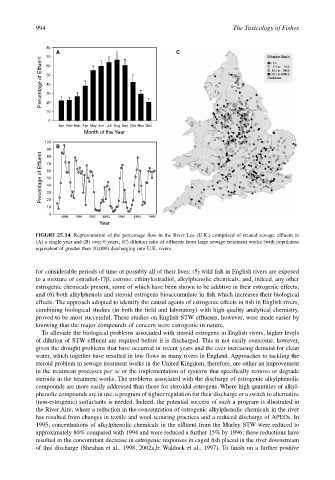Page 1014 - The Toxicology of Fishes
P. 1014
994 The Toxicology of Fishes
A C
Percentage of Effluent
Month of the Year
B
Percentage of Effluent
Year
FIGURE 25.14 Representation of the percentage flow in the River Lea (U.K.) comprised of treated sewage effluent in
(A) a single year and (B) over 6 years; (C) dilution ratio of effluents from large sewage treatment works (with population
equivalent of greater than 10,000) discharging into U.K. rivers.
for considerable periods of time or possibly all of their lives; (5) wild fish in English rivers are exposed
to a mixture of estradiol-17β, estrone, ethinylestradiol, alkylphenolic chemicals, and, indeed, any other
estrogenic chemicals present, some of which have been shown to be additive in their estrogenic effects;
and (6) both alkylphenols and steroid estrogens bioaccumulate in fish which increases their biological
effects. The approach adopted to identify the causal agents of estrogenic effects in fish in English rivers,
combining biological studies (in both the field and laboratory) with high-quality analytical chemistry,
proved to be most successful. These studies on English STW effluents, however, were made easier by
knowing that the major compounds of concern were estrogenic in nature.
To alleviate the biological problems associated with steroid estrogens in English rivers, higher levels
of dilution of STW effluent are required before it is discharged. This is not easily overcome, however,
given the drought problems that have occurred in recent years and the ever-increasing demand for clean
water, which together have resulted in low flows in many rivers in England. Approaches to tackling the
steroid problem in sewage treatment works in the United Kingdom, therefore, are either an improvement
in the treatment processes per se or the implementation of systems that specifically remove or degrade
steroids in the treatment works. The problems associated with the discharge of estrogenic alkylphenolic
compounds are more easily addressed than those for steroidal estrogens. Where high quantities of alkyl-
phenolic compounds are in use, a program of tighter regulation for their discharge or a switch to alternative
(non-estrogenic) surfactants is needed. Indeed, the potential success of such a program is illustrated in
the River Aire, where a reduction in the concentration of estrogenic alkylphenolic chemicals in the river
has resulted from changes in textile and wool-scouring practices and a reduced discharge of APEOs. In
1995, concentrations of alkylphenolic chemicals in the effluent from the Marley STW were reduced to
approximately 80% compared with 1994 and were reduced a further 15% by 1996; these reductions have
resulted in the concomitant decrease in estrogenic responses in caged fish placed in the river downstream
of this discharge (Sheahan et al., 1998, 2002a,b; Waldock et al., 1997). To finish on a further positive

